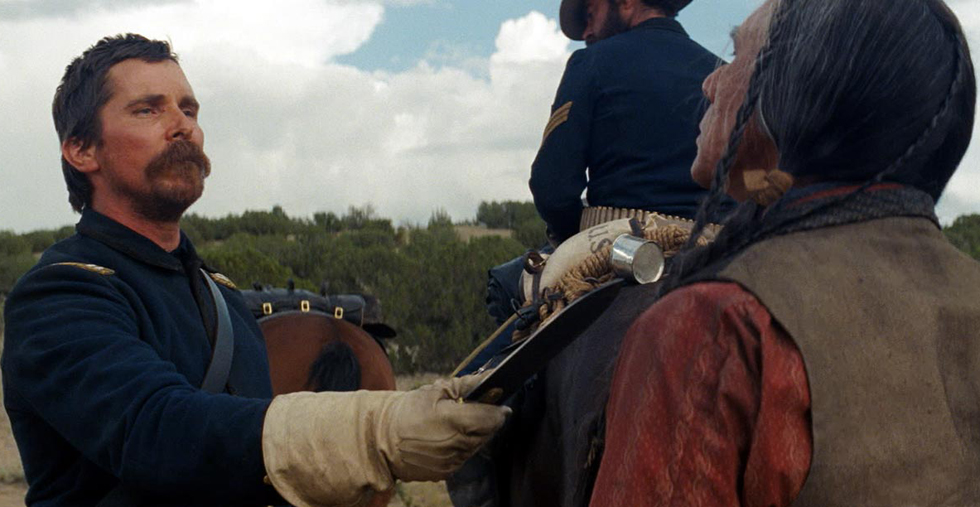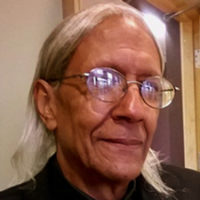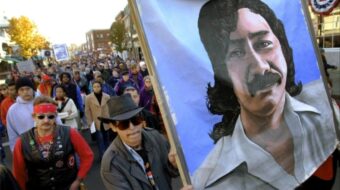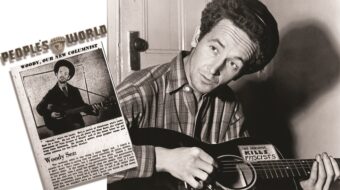
The latest Indigenous big-screen movie Hostiles, with famed stars Wes Studi (Cherokee) and Christian Bale, is evoking a lot of divergent views ranging from very positive to negative but, filled with pluses and minuses as are most movies are, it has more redemptive qualities than not.
I must preface my remarks by my experience in first attempting, unsuccessfully, to see the film.
Since the movie had been out for several weeks with little to no advertisement in Middle Tennessee where I live, I expected an auditorium with few other moviegoers. But on a cold rainy Saturday afternoon in mid-February, in a small suburb of Nashville, the movie was nearly sold out. To my pleasant surprise, the ticket seller said there were only a couple of seats left in the front row, smack up against the screen. I was told it would be showing again on Sunday afternoon, but that it was advisable to purchase tickets now, which I did. I could only reflect on my satisfaction that there was such a great interest in the film from the non-Native public.
On Sunday I took my assigned seat with only a few others in the house, eagerly awaiting seeing my favorite Native actor and fellow Cherokee, Wes Studi, whom I had the pleasure of meeting at a Native venue several years ago. The movie that is my favorite of his roles is the 1993 Geronimo. Inspirational and educational, it takes few if any liberties with history. I have watched it more times than I can count.
In the storyline of Hostiles, the dying Cheyenne war chief Yellow Hawk (Wes Studi) and his family are being escorted from New Mexico back to their Montana homeland in 1892 by an Army detachment reluctantly headed by Captain Joe Blocker (Christian Bale), who starting out has a lot of hatred for Indians. In fact Yellow Hawk was a longtime foe of Blocker. Yellow Hawk and family are being held as prisoners of war, but are released because of public pressure from back East. The chief is a “cause celebre” to Easterners. Public pressure from sympathetic Easterners for just treatment of Indigenous people in the late 19th Century was not uncommon. Their journey is beset by attacking Comanches and lawbreaking white fur trappers.
Both Studi and Bale deliver poignant and powerful performances along with the rest of the cast. The other main Indigenous actors include the famed Adam Beach (Salteaux First Nations) playing Black Hawk, the son of Yellow Hawk; noted actress Q’orianka Kilcher (Quecha/Huachipaeri) playing Elk Woman, the wife of Black Hawk; Tanaya Beatty (Da’naxda’xw First Nations), playing the sister of Black Hawk; and Xavier Horsechief (Navajo/Cherokee) playing Little Bear, the grandson of Yellow Hawk.
Before proceeding further I must comment on some remarks by non-Natives that I can only dismiss as overkill and misplaced. For example, there was a recent review in this paper entitled “‘Hostiles’: An apology for imperialism in a colorful package” by Kimball Cariou, editor of the People’s Voice, Canada’s leading socialist newspaper. He ends his remarks saying, “Placing the blame for violence on individuals Hostiles is, in the end, yet another apology for the crimes of imperialism, including genocide in the Americas.” Anyone seeing this film who has the slightest smidgen of knowledge of Indigenous history can readily perceive that the “violence” is the result of the institutionalized racism of the system of capitalism and imperialism.
An accompanying comment to this review ran as follows: “Hostiles doesn’t look as though it hits even the most modest of benchmarks—which makes the film a stone in the path of progress and a waste of the audience’s time.” I take severe exceptions to both assertions. Both are clichéd overkill statements.
In term of the positives, this is a thought-provoking film, the type of movie always needed to evoke more discussion of the current Native plight to consider how we are still living the legacy of the genocidal, blood-stained past. There is a modern-day resonance throughout the film. The injustice, the racism, the iniquity of today comprise the bitter inheritance of yesteryear. The movie is relevant for a country with racist populations of Euro-Americans who still hate with tremendous and utterly irrational abandon.
Also to be commended in the movie is the use of the Northern Cheyenne language. For this writer the use of any Native tongue is inspirational at a time when most if not all of this land’s Indigenous languages are in danger of extinction. Languages that have been spoken for thousands of years are on the cusp of demise all across the United States.
Director Scott Cooper worked with famed Native film maker Chris Eyre (Cheyenne) of Smoke Signals renown, and noted Indigenous consultant, Dr. Joely Proudfit (Pechanga/Luiseño) in making the movie. Eyre had to assemble a group of Native speakers fluent in the language who could also teach some of the language to the actors. It was great to hear Studi, who is bilingual (Cherokee is his first language), and Bale speak the language on screen, with subtitles. Let it spark more Native languages on the big screen!
Hostiles was also lauded by the National Congress of Americans (NCAI) as an “authentic representation of Native peoples” and for the accurate speaking of Native languages. In fact, NCAI partnered with The Native Networkers (TNN) and the National Indian Gaming Association (NIGA) to host a special screening of the film.
Hostiles evoked many mixed emotions on my part. I must also look at some of the negatives in it. The film starts out really taking some liberties with history. It begins with the Indians of a Comanche war party, portrayed as villainous, merciless killers, attacking an innocent, unoffending white family minding their own business—this is an old biased, grossly overworked Western theme—and killing them all, father and children, with the exception of the mother Rosalie Quaid (Rosamund Pike), who escapes the carnage, is found by the troopers and joins the trek north. In this opening scene the killing of the children goes against the grain of Native warfare in that traditional custom was to take women and children captive for either prisoner exchange or adoption.
Contemporaneously, as the white family is mowed down by Comanches an Apache family is brutally captured by Blocker and his troopers for imprisonment in the stockade. The Apache father is lassoed and dragged behind a horse. In reality, the Apache family would have been mowed down by the cavalry under the U.S. genocide policy.
The story begins in 1892, but the Comanche Wars ended in 1875 with the surrender of Quanah Parker and the Kwahadi Comanches, the last of Comanche military resistance. Hence, there would have been no Comanche resistance in 1892, as the tribe was being held on a reservation in Oklahoma.
Further, there would have been no Comanches attacking Cheyennes going north as portrayed in the film, as the two tribes were allies in the wars against the white settlers and the U.S. Army. If anything the Comanches would have been helping the Cheyennes on their trek absent the Army. Also, Cheyennes were never imprisoned in New Mexico.
When I first heard small fragments about the storyline of Hostiles I assumed it had to do with the epic historic Northern Cheyenne Exodus to escape from the Army that was trying to stop them from going back to their Montana homeland from Oklahoma. This is a true story and a very tragic one. The U.S. Army did not repatriate Native people to their ancestral homelands, but rather was deployed to stop any such repatriation by any means necessary, including the killing of any Indigenous people attempting to return home.
In fact, the true story of the Northern Cheyenne Exodus, of which I became cognizant as a child, deserves some telling, for I am sure Hostiles is a takeoff on it. In the wake of the Battle of the Little Bighorn, in 1876, the U.S. Army went after the Northern Plains Tribes, the Lakota and the Northern Cheyennes, with a vengeance. In 1877 most of the Northern Cheyennes led by Little Wolf and Dull Knife surrendered and expected to live on reservation with their Lakota allies. But the federal government ordered that the Northern Cheyenne be removed to the reservation at Fort Reno, Oklahoma, with their Southern Cheyenne relatives. They were promised by the government they could return north if the living conditions on the Oklahoma reservation were not agreeable.
The Northern Cheyenne arrived at Fort Reno in August 1877. Their living conditions sharply declined and many fell sick as malaria raged in the late summer. In the winter of 1877-78 many more were dying from hunger, due to inadequate rations, and sickness. Dysentery, fevers and depression continued to sap their energy. They were described as “homesick, heartsick and sick in every way.” In August 1878 the Northern Cheyenne decided that for the sake of survival they must return to their Montana homeland, despite government orders to the contrary. In September over 300, led by Little Wolf and Dull Knife, fled from the reservation in western Oklahoma heading to Montana. There were only eighty-five warriors to protect 250 women and children.
After six weeks of outfighting and outmaneuvering 17,000 soldiers sent to bring them back to Oklahoma, the Cheyenne decided to split into two groups. One group decided to stop running and follow Dull Knife to the Red Cloud Agency, where they hoped to reside among their Lakota allies. The band led by Dull Knife consisted mostly of women, children and the elderly. The other group elected to continue to the Powder River Country in Montana.
In October 1878, on their way to the Red Cloud Agency the Dull Knife group by happenstance ran into an Army detachment. As they were outnumbered and outgunned, it was agreed that they would go to Fort Robinson, Nebraska, pending further arrangements. At Fort Robinson the Cheyenne agreed to cease fighting if they could live on the Pine Ridge Reservation with Red Cloud. They were confined to an army barracks about the size of a tennis court, built to hold only 75 soldiers. The Cheyenne numbered 148. They were given food, water and firewood.
But in January 1879 the government ordered that the Army return the Cheyenne to the Oklahoma reservation. The Cheyenne said they would rather die than return south. The stage was set for the worst tragedy. Soldiers put bars on the barracks and cut off food, water and wood for heat for four days. The temperature stood at sub-zero. What happened next has gone down in history as the Fort Robinson Massacre.
On the night of January 9th, with the temperature at 40 degrees below zero, the Cheyenne made their escape using guns they had hidden when taken into custody. They were cornered in the cold and snow after breaking into smaller groups to avoid capture, and most were mercilessly killed by the cavalry. One group of 32 escapees who were trapped in a dry creek bed had only eight survivors.
The killings in the creek bed, which came to be known as the “Pit,” were immortalized by storied Western artist Frederic Remington in his painting of the same name in 1897. Out of the original number of 148 only about ten escaped the murderous onslaught of the U.S. Cavalry. Sixty-five others, 23 of them wounded, were taken back to Fort Robinson as prisoners.
The group led by Little Wolf fared better; in fact, comparatively speaking, they triumphed. They made it to Montana where, after negotiation with an army officer known to be sympathetic to the Cheyenne, they were allowed to remain undisturbed. These Cheyenne became the nucleus of the Northern Cheyenne Reservation at Lame Deer, Montana, and were never forced to return to Oklahoma.
Dull Knife and some family members were among those who escaped and reached the Red Cloud Agency. After months of Washington red tape, the prisoners at Fort Robinson and Dull Knife were allowed to join Little Wolf’s band in Montana. The Cheyennes had triumphed despite terrible losses.
In the chronicles of the Plains Wars, the bravery of the Cheyennes was legendary, though earned through horrific, epic struggle.
Later, the massacre at Fort Robinson was considered so egregious that General George Crook, also a noted so-called “Indian Fighter,” sent a board of officers to investigate.
In my estimation this would have made for a much better storyline. I still ponder why the date of 1892 was chosen, as this inexplicably took too much liberty with history. Just another Hollywoodism, I surmise. Also, I found disappointing that the two Indigenous women in the film, Kilcher and Beatty, had little to no speaking roles.
Another disconcerting part of the film was that after all the remaining Natives are killed, the surviving Indian boy, Little Bear, played by Xavier Horsechief, is apparently adopted by the white woman character, Rosalie, and, dressed in a “little white boy suit,” leaves with her on a train departing Butte, Montana, headed for Chicago. Obviously, he is being taken away from his people (there were still Cheyennes around) to be assimilated into the white world. Not a happy ending for Indigenous viewers. More food for provoking thought in the present-day.
But all told, this a film that definitely should be seen. It puts squarely on the table of national discussion the contemporary plight of Indigenous people relating to the ever-present issues of genocide, land theft, reparations, assimilation, kidnapping of Native children, private property and capitalist/imperialist Manifest Destiny. The film resonates with a focus on today’s survival issues for Indigenous people.












Comments